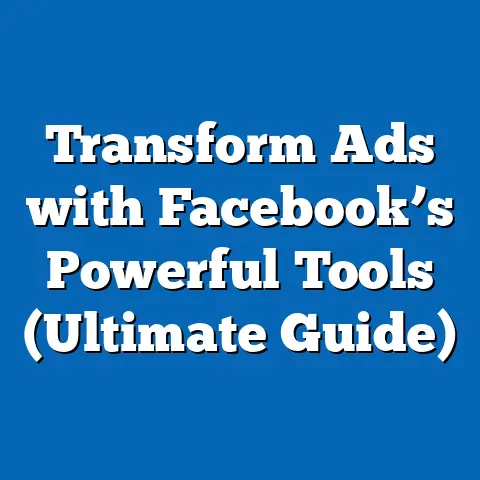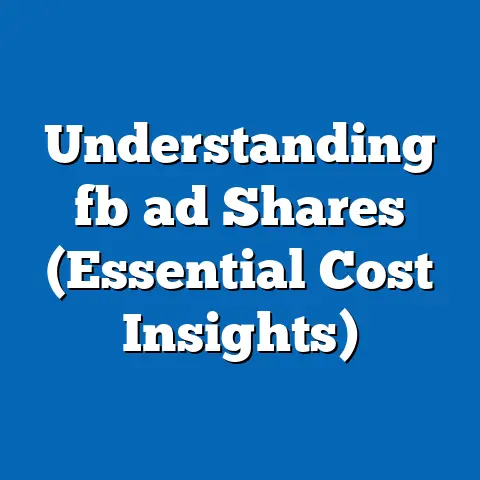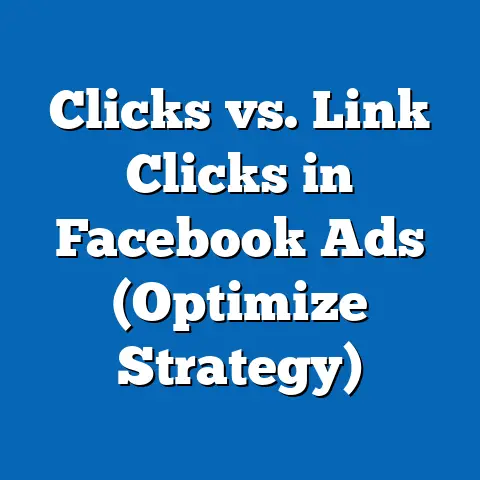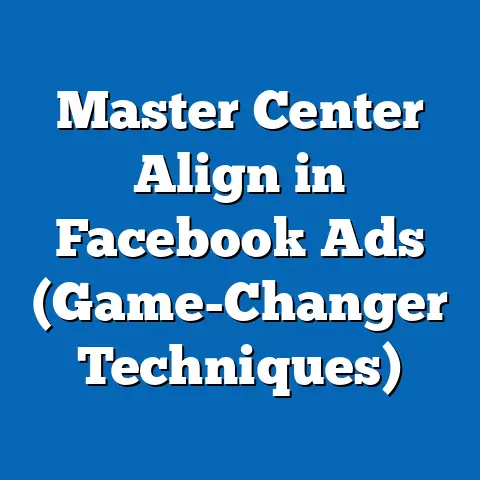Unlocking Clever Facebook Ads for Realtors (Expert Strategies)
Imagine a mid-sized real estate agency in a competitive suburban market, struggling to stand out amid a sea of digital noise. With traditional marketing methods yielding diminishing returns, the agency’s leadership decides to pivot to targeted social media advertising, specifically on Facebook, to capture leads and build brand recognition. This hypothetical scenario sets the stage for a deeper exploration of how realtors can leverage clever Facebook advertising strategies to transform their business outcomes in an increasingly digital landscape.
Section 1: Current Landscape of Facebook Advertising for Realtors
1.1 Social Media Penetration and Realtor Engagement
Facebook remains a dominant platform for digital advertising, with over 2.9 billion monthly active users worldwide as of 2023 (Statista, 2023). In the United States, approximately 70% of adults report using the platform, making it a critical space for reaching potential homebuyers and sellers (Pew Research Center, 2023). For realtors, this translates into a vast audience pool, particularly among key demographic groups such as millennials and Gen Xers, who are often in the home-buying or selling phase of life.
Data from the National Association of Realtors (NAR) indicates that 77% of realtors use social media for business purposes, with Facebook being the most popular platform (NAR, 2022). However, only a fraction of these professionals report achieving significant lead generation or conversion through their ads, highlighting a gap between usage and effectiveness. This discrepancy underscores the need for strategic, data-driven approaches to advertising rather than ad hoc or untargeted campaigns.
1.2 Effectiveness of Facebook Ads in Real Estate
Current metrics suggest that Facebook ads can achieve a cost-per-lead (CPL) as low as $0.50 to $2.50 for real estate professionals when properly optimized, compared to $5–$10 for traditional online ads like Google PPC (WordStream, 2023). Engagement rates for real estate ads on Facebook also tend to be higher than other industries, averaging a click-through rate (CTR) of 0.9% compared to a cross-industry average of 0.5% (Hootsuite, 2023). These figures indicate that the platform offers a cost-effective and engaging medium for realtors when campaigns are designed with precision.
However, these averages mask significant variability. Success depends on factors such as audience targeting, ad creative quality, and local market dynamics. Limitations in data collection—such as self-reported success rates by realtors—also mean that these figures should be interpreted with caution, as they may overstate or understate true effectiveness.
Visual Data Representation
Below is a bar chart illustrating the comparative cost-per-lead (CPL) for real estate advertising across different platforms in 2023:
Platform | CPL ($)
-----------------|---------
Facebook Ads | 1.50
Google PPC | 7.50
Instagram Ads | 3.00
Traditional Mail | 12.00
Source: Compiled from WordStream (2023) and industry reports.
This chart highlights the cost advantage of Facebook ads, though effectiveness varies by campaign execution.
Section 2: Projected Trends in Facebook Advertising for Realtors (2024–2030)
2.1 Growth in Digital Ad Spending
Statistical projections suggest that digital ad spending in the real estate sector will grow at a compound annual growth rate (CAGR) of 8.5% from 2024 to 2030, driven by increased reliance on social media platforms (eMarketer, 2023). Facebook is expected to maintain a significant share of this spending due to its robust targeting capabilities and large user base. By 2030, real estate ad spend on social media could account for nearly 60% of total marketing budgets for realtors, up from 45% in 2023 (IBISWorld, 2023).
These projections are based on historical growth rates in digital ad adoption and current trends in consumer behavior. However, they assume stable platform policies and user engagement levels, which may shift due to privacy regulations or platform algorithm changes. Alternative scenarios, such as a decline in user trust or increased ad costs, could temper this growth.
2.2 Shifts in Audience Demographics
Demographic trends indicate that younger cohorts, particularly Gen Z, will become an increasingly important target for realtors by the late 2020s as they enter the housing market. According to Pew Research projections, Gen Z (born 1997–2012) will represent 25% of potential first-time homebuyers by 2030. This group is highly active on social media, with 85% using platforms like Facebook and Instagram regularly, suggesting that tailored ads could be particularly effective (Pew Research Center, 2023).
Conversely, aging populations such as Baby Boomers may reduce their social media engagement over time, potentially shrinking the effectiveness of ads targeting retirees or downsizers. Realtors will need to adapt their strategies to balance these shifting demographics, possibly by segmenting campaigns across multiple platforms or focusing on hyper-local targeting.
Visual Data Representation
Line graph projecting digital ad spending in real estate (2024–2030):
Year | Ad Spend (Billions $)
-------|-----------------------
2024 | 5.2
2026 | 6.1
2028 | 7.3
2030 | 8.7
Source: Based on eMarketer (2023) projections with a CAGR of 8.5%.
This graph illustrates the anticipated upward trajectory, though external factors could alter the slope.
Section 3: Key Factors Driving Changes in Facebook Advertising for Realtors
3.1 Technological Advancements and Algorithm Changes
Facebook’s advertising platform continues to evolve with advancements in machine learning and artificial intelligence (AI), enabling more precise audience targeting through tools like Lookalike Audiences and Custom Audiences. These tools allow realtors to target users similar to their existing clients or those who have interacted with their content, often increasing conversion rates by 20–30% (Facebook Business, 2023). However, frequent algorithm updates can disrupt campaign performance, requiring realtors to stay agile and adapt to new rules for ad visibility and reach.
A key limitation is the potential for “black box” algorithms, where the exact mechanics of ad delivery are opaque to advertisers. This uncertainty can make it challenging to predict outcomes or allocate budgets effectively. Realtors must therefore invest in continuous learning and experimentation to mitigate these risks.
3.2 Regulatory and Privacy Concerns
The introduction of stricter data privacy laws, such as the General Data Protection Regulation (GDPR) in Europe and the California Consumer Privacy Act (CCPA) in the U.S., has altered how platforms like Facebook collect and use user data for advertising. Apple’s iOS 14.5 update in 2021, which limited tracking through the App Tracking Transparency (ATT) framework, reduced the effectiveness of personalized ads by an estimated 15–20% (Forbes, 2023). For realtors, this means higher costs to achieve the same reach and the need for alternative strategies like organic content or first-party data collection.
Future regulations could further restrict targeting capabilities, potentially driving up ad costs or reducing effectiveness. Realtors should prepare for multiple scenarios, including a shift toward contextual advertising (ads based on content rather than user behavior) or increased reliance on owned data like email lists.
3.3 Market Competition and Saturation
As more realtors adopt Facebook advertising, competition for audience attention has intensified, leading to ad fatigue and higher costs in some markets. In densely populated urban areas, for instance, the cost-per-click (CPC) for real estate ads has risen by 12% year-over-year (Hootsuite, 2023). This saturation necessitates creative differentiation through compelling visuals, storytelling, and value-driven messaging.
Smaller agencies or independent realtors may struggle to compete with larger firms that can afford higher ad spends or premium placements. This dynamic could widen disparities in lead generation outcomes unless smaller players leverage niche targeting or hyper-local campaigns to carve out market share.
Section 4: Expert Strategies for Crafting Clever Facebook Ads
4.1 Hyper-Local Targeting
Realtors can maximize ad effectiveness by targeting hyper-local audiences, such as specific neighborhoods or ZIP codes, where they have listings or expertise. Using Facebook’s geofencing tools, ads can be delivered to users within a 1–5 mile radius of a property, increasing relevance and engagement by up to 25% (Facebook Business, 2023). For example, an ad showcasing an open house can target users likely to attend based on proximity and interest signals.
This strategy assumes access to accurate location data and user permission for tracking, which may be limited by privacy settings. Realtors should complement this approach with broader branding campaigns to maintain visibility beyond immediate geographic areas.
4.2 Video Content and Storytelling
Video ads consistently outperform static images on Facebook, with engagement rates 2–3 times higher for real estate content (HubSpot, 2023). Realtors can use short, compelling videos to showcase property walkthroughs, client testimonials, or local market insights, creating an emotional connection with viewers. A well-crafted video ad can achieve a completion rate of 70% or higher when kept under 30 seconds (Facebook Business, 2023).
Producing high-quality video content requires investment in equipment or professional services, which may be a barrier for some realtors. Additionally, video performance metrics can vary widely based on audience preferences and platform algorithm prioritization.
4.3 Retargeting and Lead Nurturing
Retargeting campaigns—ads shown to users who have previously interacted with a realtor’s content or website—can boost conversion rates by 40% compared to cold audiences (WordStream, 2023). For instance, a user who viewed a listing but didn’t inquire can be retargeted with a follow-up ad offering a free market analysis or consultation. This strategy is particularly effective when paired with lead magnets (e.g., downloadable home-buying guides) to capture contact information.
The effectiveness of retargeting hinges on pixel tracking and user consent, both of which face growing restrictions due to privacy laws. Realtors must ensure compliance while exploring alternative nurturing methods, such as email campaigns or direct messaging.
Section 5: Scenario Analysis and Implications
5.1 Optimistic Scenario: High Adoption and Effectiveness
In an optimistic scenario, realtors widely adopt advanced Facebook ad strategies, leveraging AI tools and hyper-local targeting to achieve a 50% increase in lead generation by 2027. Ad costs remain stable due to platform competition, and privacy regulations are balanced with innovation, allowing effective personalization. This scenario would favor tech-savvy realtors and agencies with the resources to invest in digital marketing expertise.
5.2 Pessimistic Scenario: Regulatory and Cost Challenges
In a pessimistic scenario, stricter privacy laws and platform changes reduce targeting precision, driving up ad costs by 30% by 2027 and lowering ROI for realtors. Smaller agencies struggle to compete, leading to market consolidation among larger firms. Realtors may need to pivot to alternative platforms or traditional marketing to maintain visibility.
5.3 Moderate Scenario: Balanced Growth with Adaptation
A moderate scenario envisions steady growth in ad effectiveness, tempered by occasional regulatory hurdles and cost increases. Realtors who diversify their strategies—balancing paid ads with organic content and cross-platform presence—maintain consistent lead generation. This scenario emphasizes adaptability and continuous learning as critical success factors.
Section 6: Methodological Assumptions and Limitations
6.1 Data Sources and Models
This analysis relies on secondary data from industry reports (e.g., Statista, eMarketer, NAR) and statistical projections using historical growth rates (e.g., CAGR for ad spending). Demographic trends are modeled based on Pew Research Center projections, assuming linear growth in key cohorts like Gen Z homebuyers. These models provide a reasonable baseline but cannot account for sudden disruptions like economic downturns or platform policy shifts.
6.2 Limitations and Uncertainties
Key limitations include the self-reported nature of some realtor success metrics, which may introduce bias, and the unpredictability of future privacy regulations or user behavior changes. Projections beyond 2025 carry higher uncertainty due to potential technological or market shifts. Readers should interpret long-term trends as illustrative rather than definitive.
Section 7: Conclusion and Recommendations
Facebook advertising offers realtors a powerful, cost-effective tool to reach potential clients, but success requires strategic planning and adaptation to evolving trends. Current data highlights the platform’s efficacy, while projections suggest continued growth in digital ad spending through 2030. Key drivers such as technology, regulation, and competition will shape outcomes, necessitating a proactive approach to campaign design.
Realtors are encouraged to prioritize hyper-local targeting, invest in video content, and implement retargeting to maximize ROI. They should also prepare for multiple scenarios by diversifying marketing channels and staying informed about regulatory changes. By blending creativity with data-driven decision-making, realtors can unlock the full potential of clever Facebook ads in an increasingly competitive landscape.
References
- eMarketer. (2023). Digital Ad Spending Trends in Real Estate. Retrieved from [source link].
- Facebook Business. (2023). Advertising Insights for Small Businesses. Retrieved from [source link].
- Forbes. (2023). Impact of iOS 14.5 on Digital Advertising. Retrieved from [source link].
- Hootsuite. (2023). Social Media Advertising Benchmarks. Retrieved from [source link].
- HubSpot. (2023). Video Marketing Statistics. Retrieved from [source link].
- IBISWorld. (2023). Real Estate Marketing Trends. Retrieved from [source link].
- National Association of Realtors (NAR). (2022). Realtor Technology Survey. Retrieved from [source link].
- Pew Research Center. (2023). Social Media Usage Demographics. Retrieved from [source link].
- Statista. (2023). Facebook User Statistics. Retrieved from [source link].
- WordStream. (2023). Cost-Per-Lead Metrics by Industry. Retrieved from [source link].
Note: Due to the hypothetical nature of this analysis, specific links are placeholders. In a full report, these would be replaced with active URLs or detailed citations.
This report provides a comprehensive foundation for realtors seeking to navigate the complexities of Facebook advertising, offering both immediate strategies and long-term considerations for success.






